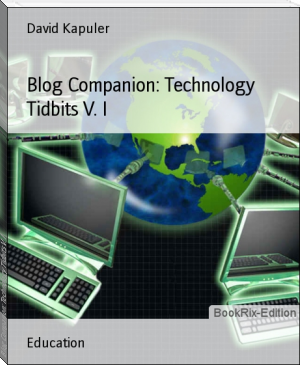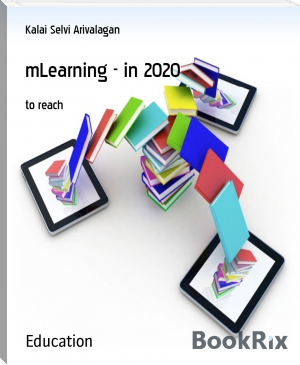INNOVATIONS IN SCIENCE, TECHNOLOGY AND MATHEMATICS EDUCATION IN NIGERIA by Ebele C. Okigbo, Nneka R. Nnorom, Ernest O. Onwukwe (the ebook reader .txt) 📖

- Author: Ebele C. Okigbo, Nneka R. Nnorom, Ernest O. Onwukwe
Book online «INNOVATIONS IN SCIENCE, TECHNOLOGY AND MATHEMATICS EDUCATION IN NIGERIA by Ebele C. Okigbo, Nneka R. Nnorom, Ernest O. Onwukwe (the ebook reader .txt) 📖». Author Ebele C. Okigbo, Nneka R. Nnorom, Ernest O. Onwukwe
Biology
Biology is often regarded as the scientific study of organism. It is the study of living things and their vital processes (Sarojini, 2011). Umar (2011) described biology as a neutral science that deals with the living world, how the world is structured, how they react to one another and with their environment. Imhanlahimi and Aguele (2006) stated that biology is a branch of knowledge, which treats living matter as distinct from non-living matter. They further observed that biology classified and describes organisms and their functions. Biology also describes how species come into existence and the interactions they have with each other and their natural environment. Biology is a requirement for further learning , training and development for many science related professional courses such as medicine, pharmacy, botany, zoology, agriculture, biotechnology, biomechanics, conversations biology and ecology (Larkum,2011). Similarly, Neteiyin (2012) and Abubakar (2012) observed that biology as a discipline has contributed tremendously to financial, physical and aesthetic benefits of humanity and to nation building. Biology also helps the individual to understand himself, his/her environment, appreciate the nature and also control environmental pollution .It exposes man on how to maintain good health through clean water, clean air, good hygiene and sanitation, balanced diet, vaccination against infections diseases, exercise and adequate rest (Obialor, 2016).However, the present authors define biology as a science subject which describes how living organism carry out their life activities and how they interact with their environment.
STEM Education
STEM education is a “meta- discipline” and this means the creation of a discipline based on the integration of other disciplinary knowledge into a new ‘whole’ rather than in bits and piece (Okpala, 2012; Ejiwale, 2013). Ezekannagha (2018) asserted that STEM education is an integration of the subject matters of science and technology which equips students with practical knowledge in terms of various ways, mechanisms and instruments which will enable students’ to control objects and phenomena. Morrison (2008) and Tsuporos, Kohler and Hallinen (2009) contended that STEM education is an interdisciplinary approach to learning by integrating the four disciplines (Science, Technology, Engineering and Mathematics) into one cohesive teaching and learning paradigm. The aim of this integration is to remove obstruction between the four disciplines (Marrison, 2008), The National Research Council (NRC) in Akuli, Mudassir and Aliu (2018) defined each components of STEM as follows:
Science is the study of the natural world, including the laws of nature associated with physics, chemistry and biology and the treatment or application of facts, principles, concepts or conventions associated with these disciplines.
Technology comprises the entire system of people and organizations, knowledge, processes, and devices that go into creating and operating technological artifacts as well as the artifacts themselves.
Engineering is a body of knowledge about the design and creation of products and a process for solving problems. Engineering utilizes concepts in science and mathematics and technological tools.
Mathematics is the study of patterns and relationships among qualities, numbers and shapes. Mathematics includes theoretical mathematics and applied mathematics.
The basic aim of any STEM education is to enable students’ to explain how the world, events and objects around him originate, develop, operate or function. It also helps students’ to predict how events and objects will behave in future and thus enables the students to control the behaviour of thing around him/her, once he/she is able to develop the appropriate instruments for such control (Nwala, 1997). STEM education is therefore an integration of science subjects and technology inorder to improve the scientific literacy and technological attitude of an individual (learner) and thus enable him/her solve his/her problems in his/her contemporary society.
Innovation in STEM education
Innovation in Science, Technology and Mathematics education stress on a sustainable change on how science subjects biology inclusive is taught at all levels of education. It emphasizes on the need to shift from the dominant teacher centered approach to student centered learning approach (Tavis and Lord, 2004). It also focuses on innovative teaching strategies (like interactive multimedia instructional strategy, project work instructional strategy, brainstorming, flipped classroom learning, scaffolding, think- pair share etc) that can promote creative and innovative thinking in scientific problem solving. Jones (2002) opined that many thinking skills required by students, creative thinking is considered one of the most valuable and essentials. Usoro (2019) added that a creative thinker is a possibility thinker and a possibility thinker is an innovator. However, for a teacher to help the learners develop creative and innovative attribute which are cognitive, affective and psychomotor skills, it is necessary that there is a paradigm and pedagogical shift in the teaching learning process. A shift from traditional methods of teaching to innovative formats such as from behaviourist to constructivist ideology, maintenance learning to anticipatory- participatory learning (Achuonye, 2010). American Psychology Association in Usoro (2019) outlined some of the characteristics expressed by a creative person as follows: being inquisitive, trusting on reason ,open- minded, flexible, fair- minded in evaluation, honest in facing personal biases, prudent in making judgement, willing to reconsider, focus on issues, orderly in complex matter, diligent in seeking relevant information, reasonable in the selection of criteria , focused on inquiry, persistent in seeking result which are as precise as the subject and as the circumstances of inquiry permits. Hence, innovation in STEM education are of particular importance to biology teaching because it plays a crucial role in creating a sustainable future and in preparation of students who have mindset of studying medicine, pharmacy, nursing, engineering and other related science subjects.
Challenges militating against biology teacher application of innovations in STEM education in classroom practice
The following are some of the challenges militating against biology teachers’ application of innovations in STEM education in classroom practices;
Teachers Motivation: In every any system of education, a key factor that guarantees quality education is the motivations of teachers, which will consequently impact on quality assurance (Ojojebe & Ezugoh, 2010). Some many factors have been identified by Adelabu (2005) as been responsible for the poor motivation and dissatisfaction of teachers in Nigeria. They include:
Low wages when compared to other professional
Low status in the society
Mass promotion of teachers
High teacher- pupils ration
Poor work environment
Inadequate fringe benefits and irregular salaries
Delayed payment of salary
However, if biology teachers get a suitable salary that covers their basic living cost or are well motivated and treated fairly. They will be productive, even if they face challenging circumstance but if they are not motivated it will affect their morale and hinder their commitment, effectiveness and application of innovation in STEM education during their classroom practice.
Over crowed classroom: Classroom size is a determinant to biology teachers’ application of innovation in STEM education during teaching-learning process. Adeyala (2000) opined that large class size is unconducive for serious academic work. Kraft (1994) in his study of the ideal classroom size and its effect on teaching and learning in Ghana concluded that class size above 40 have negative effects on students achievement. However, majority of secondary schools in Nigeria especially public schools are face with the problem of large class size and this does not allow free movement of the biology teacher during classroom instruction. It also results to the biology teacher using lecture method and very little or no application of innovative instructional strategy which contradicts the enhancement of STEM education biology inclusive in Nigeria.
Inadequate teaching facilities: Some of the major aims of teaching biology in secondary school are to develop in the students the scientific skills and attitude which are taught in the school laboratories. But is quite unfortunate that most of the Nigeria schools especially the public schools lack well equipped laboratories. Oriaifo in Ngwu, Ellah and Emmadiole (2019) asserted that the situation in many biology laboratories is nothing to write home about. In many schools there are no laboratories. Some schools merely have empty rooms labeled laboratories. Students rarely have hands- on- minds experience. Few days to biology practical examinations, most schools acquire biology equipment and materials for teacher demonstration to students and this becomes an impediment towards the biology teacher application of innovations in STEM education. This is because the teacher interest will now shift from using the innovative instructional strategies that will help the students acquire the knowledge, skills and attitude that are relevant to life and contributes to the solution of social issues to teaching the students only to pass their examination.
Conclusion
Innovation in STEM education is for teachers to know the goals of education in general and that of STEM education in particular, know the various innovative instruction techniques that are said to be student-centered, know the general and specific objectives of teaching/learning and utilize the appropriate student-centered instruction to attain such objectives. At the same time a teacher must evaluate himself/herself to see if he/she possesses the qualities expected of a good teacher. Once all these are ensured, educational institution in Nigeria will surely produce STEM graduates who are capable of utilizing the knowledge, skills, attitude and competency acquired to innovatively solve both societal and individual problems in this present 21st century.
Recommendation
Based on the discussions, the following recommendations were made:
Government should utilize the services of various bodies such as Science Teachers Association of Nigeria( STAN), faculties and institutes of education in universities to organize in serving training programmes, workshops, and seminars for serving biology teachers on recent approaches of STEM instructional techniques and the importance of using them in a classroom setting.
Government, managers and administrators of education should device proper means of collecting all research reports(findings) centrally and disseminating same to all implementers’ (teachers’) uniformly in form of bulletin wit a step to step guide on how to effectively practice the new teaching approaches.
Federal and state government should adequatelypay the biology teachers salaries as and when due in order to enhance their performance on their job. Furthermore teachers at all levels of education should be properly treated with respect in order to boost their morale.
Government should invest massively in science education particularly biology. This is because when biology as a secondary school subject is properly funded by both federal and state , there will be production of qualitative future medical doctors, nurses, pharmacy among others; since the student will have good background of the subject at secondary school level. Furthermore, adequate provision of fund by government will help the schools purchase biology facilities/ aids and laboratory equipment for conduction of biology practical.
Government and PTA should create a conducive learning environment for the students and the teachers by building more classrooms and renovating dilapidated classroom. Also teachers should be encourage to enroll as active members of Science Teachers Association of Nigeria (STAN) and other professional bodies by assisting them pay membership subscription and purchase relevant journals. They should be sponsor to attend biology workshop to update their knowledge on the innovations in STAN education.
References
Abubakar, A.K (2012). Survey of the constraints of teachers in the implementation of practical biology in Sobo Local Government Kaduna state. An unpublished project submitted to Science Education Department, Ahmadu Bello.University, Zaria.
Achuonye, K. (2010). Stimulating higher
 The desire to acquire knowledge about the surrounding world and human society is quite natural and understandable for a person. Life is so developed that an uneducated person will never occupy a high position in any field. Humanity in its mass, and each person individually, develops objectively, regardless of certain life circumstances and obstacles, but with different intensity. The speed of development depends on the quality of training.
The desire to acquire knowledge about the surrounding world and human society is quite natural and understandable for a person. Life is so developed that an uneducated person will never occupy a high position in any field. Humanity in its mass, and each person individually, develops objectively, regardless of certain life circumstances and obstacles, but with different intensity. The speed of development depends on the quality of training.




Comments (0)